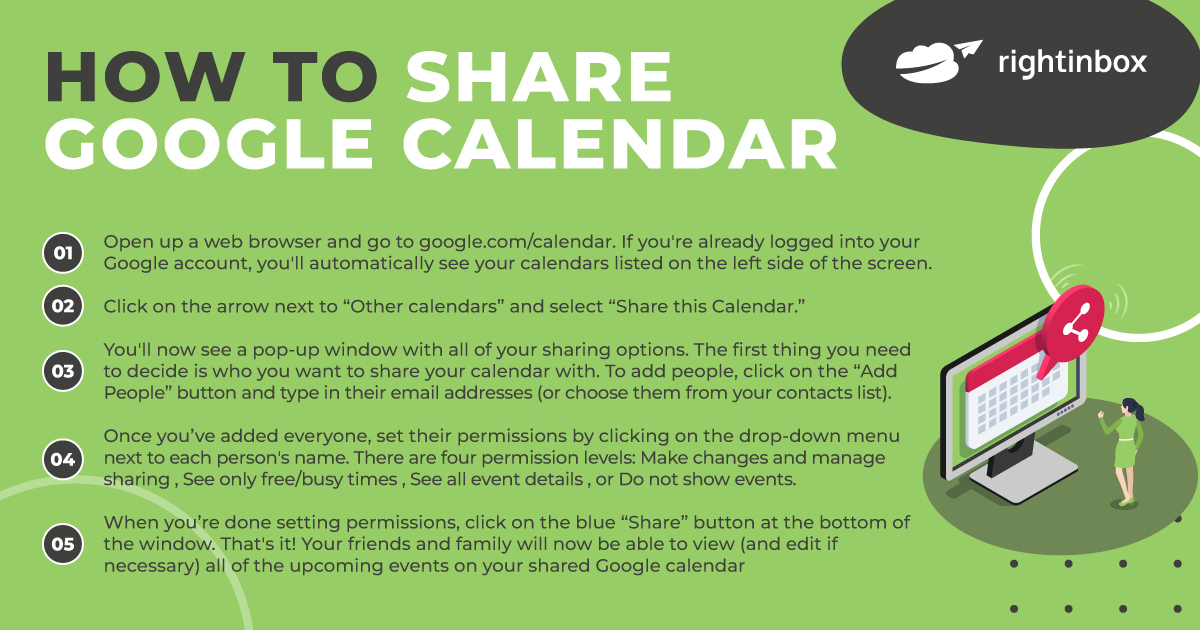Mastering Google Calendar Sharing: A Complete Information for People and Groups
Associated Articles: Mastering Google Calendar Sharing: A Complete Information for People and Groups
Introduction
With enthusiasm, let’s navigate by way of the intriguing matter associated to Mastering Google Calendar Sharing: A Complete Information for People and Groups. Let’s weave fascinating data and supply contemporary views to the readers.
Desk of Content material
Mastering Google Calendar Sharing: A Complete Information for People and Groups

Google Calendar is a ubiquitous device for managing schedules, appointments, and deadlines. However its true energy lies in its collaborative capabilities. Sharing calendars permits people and groups to seamlessly coordinate schedules, keep away from conflicts, and enhance total productiveness. Nonetheless, successfully managing shared calendars, particularly with a lot of contributors or advanced scheduling wants, requires a nuanced understanding of its options and finest practices. This text delves into the intricacies of making and managing shared Google Calendars, overlaying all the pieces from fundamental sharing to superior methods for optimizing collaboration.
Half 1: Creating and Sharing a Google Calendar
The method of making and sharing a Google Calendar is surprisingly easy. This is a step-by-step information:
-
Making a New Calendar: Begin by logging into your Google account and navigating to calendar.google.com. Click on on the "+" icon situated within the left-hand sidebar, normally labeled "Create calendar." It will open a brand new window the place you may give your calendar a reputation (e.g., "Staff Venture Calendar," "Household Occasions," "Advertising and marketing Conferences"). You too can add an outline and a location if needed. Click on "Create calendar" to finalize the method.
-
Sharing the Calendar: As soon as created, the brand new calendar will seem in your record of calendars. To share it, click on on the three vertical dots (Extra actions) subsequent to the calendar’s identify. Choose "Settings and sharing." It will open a brand new tab with the calendar’s settings.
-
Granting Entry: Within the "Share with particular individuals" part, you will discover a subject the place you may enter the e-mail addresses of people you want to share the calendar with. For every electronic mail tackle, you might want to choose the suitable permission stage:
-
See solely free/busy data: This enables recipients to see if you’re busy, however not the small print of your occasions. That is superb for sustaining privateness whereas nonetheless permitting others to schedule conferences round your availability.
-
See all occasion particulars: This grants full entry to all occasions on the calendar, together with titles, descriptions, and places. That is appropriate for collaborators who want detailed data to take part successfully.
-
Make modifications to occasions: This permission stage permits recipients to edit and delete occasions on the calendar. Use this cautiously and solely with trusted people. That is helpful for collaborative scheduling the place a number of individuals must handle the calendar.
-
Add occasions: This permission permits the recipient so as to add new occasions to the shared calendar.
-
After specifying the permission stage for every particular person, click on "Ship." Google will ship an electronic mail notification to every recipient, inviting them to entry the shared calendar.
Half 2: Superior Sharing Methods and Greatest Practices
Whereas the fundamental sharing course of is easy, optimizing shared calendars for bigger groups or advanced tasks requires a deeper understanding of superior methods:
-
Utilizing Google Teams: For giant groups or tasks involving many people, making a Google Group is extremely really useful. As a substitute of individually including every individual’s electronic mail tackle, you may add the group electronic mail tackle. This simplifies administration and ensures that everybody throughout the group robotically receives entry to the calendar.
-
Calendar Colour Coding: Completely different calendars could be color-coded to simply distinguish them at a look. That is notably useful when managing a number of shared calendars concurrently. You may customise the colour of every calendar within the "Settings and sharing" menu.
-
Creating Sub-calendars: For advanced tasks or groups with quite a few sub-teams, contemplate creating sub-calendars inside the primary calendar. This enables for a extra organized and hierarchical construction, making it simpler to handle particular person points of a bigger venture. You may then share particular sub-calendars with related people or groups.
-
Using Notifications and Reminders: Configure notification settings to obtain well timed reminders about upcoming occasions on shared calendars. This ensures that nobody misses vital conferences or deadlines. Customise notification settings for every calendar individually to optimize your workflow.
-
Public Calendars (Use with Warning): For publicly accessible data, equivalent to workplace hours or occasion schedules, you can also make a calendar public. Nonetheless, train excessive warning with this characteristic, because it exposes all occasion particulars to anybody with the hyperlink. Make sure that the data shared is acceptable for public viewing.
-
Managing Permissions: Usually evaluate and replace permission ranges to make sure that solely licensed people have entry to the calendar. Take away entry for people who’re now not concerned within the venture or workforce.
-
Using Calendar Subscriptions: If you might want to entry a calendar that another person has shared publicly, you may subscribe to it. This provides the calendar to your record of calendars with out requiring specific permission from the proprietor.
-
Integration with Different Google Companies: Google Calendar seamlessly integrates with different Google companies, equivalent to Google Meet and Gmail. This lets you schedule conferences straight from the calendar and ship assembly invites through electronic mail effortlessly.
Half 3: Troubleshooting Widespread Points
Regardless of the simplicity of the fundamental sharing course of, some frequent points can come up:
-
Recipient Can not Entry the Calendar: Confirm that the e-mail addresses are right and that the recipient has accepted the sharing invitation. Verify their spam folder for the invitation electronic mail.
-
Permission Points: Make sure that the suitable permission stage has been granted. If the recipient must edit occasions, be sure to’ve chosen the "Make modifications to occasions" possibility.
-
Calendar Not Syncing: Verify the calendar’s sync settings on each your machine and the Google Calendar web site. Make sure that your machine is related to the web and that the calendar is accurately configured.
-
Conflicting Occasions: Shared calendars can generally result in conflicting occasions. Cautious planning and communication amongst workforce members are essential to keep away from this difficulty. Think about using options just like the "free/busy" data to verify availability earlier than scheduling occasions.
Half 4: Greatest Practices for Giant-Scale Calendar Administration
Managing shared calendars with quite a few contributors and sophisticated scheduling wants requires a extra structured strategy:
-
Set up Clear Naming Conventions: Use constant and descriptive names for calendars and occasions to keep away from confusion.
-
Develop a Calendar Administration Coverage: Create pointers for a way the calendar must be used, who has entry to which calendars, and what data must be included in occasions.
-
Usually Audit and Clear Calendars: Delete outdated occasions and take away entry for people who’re now not concerned. This retains the calendar organized and prevents litter.
-
Make the most of Calendar Templates: Create templates for recurring conferences or occasions to avoid wasting time and guarantee consistency.
-
Implement a System for Battle Decision: Set up a transparent course of for resolving scheduling conflicts that will come up.
-
Present Coaching and Assist: Make sure that all customers perceive the right way to use the shared calendar successfully.
By implementing these methods and finest practices, you may remodel Google Calendar from a easy scheduling device into a robust engine for collaboration and productiveness. Efficient calendar sharing is essential for profitable teamwork, environment friendly venture administration, and streamlined communication. Mastering its options and addressing potential challenges ensures a smoother and extra productive workflow for everybody concerned.




![[Google Workspace Course] Mastering Google Calendar for Event Planning](https://file.reskills.com/files/14Oct2023-AdriYanto.jpg)



Closure
Thus, we hope this text has supplied beneficial insights into Mastering Google Calendar Sharing: A Complete Information for People and Groups. We admire your consideration to our article. See you in our subsequent article!